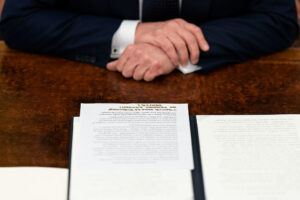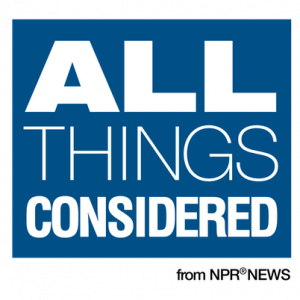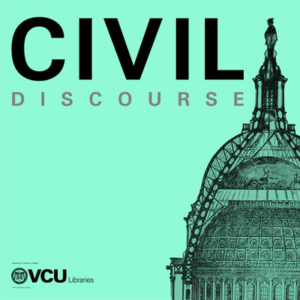
On October 6, 2022, U.S. President Joe Biden announced an executive order that, in part, pardoned thousands of federal marijuana possession convictions. The President also stated that his administration would review whether marijuana should still be in the same legal category as drugs such as heroin. This order was picked up by the national news outlets where pundits and legal experts vigorously discussed the pardon and its wide-ranging impacts. Though the coverage around this order was substantial, it was by no means the first executive order President Biden had issued. Since taking office, President Biden has signed 103 executive orders, directives written by the president to officials within the executive branch requiring them to take or halt an action related to federal policy or administration.
Though there are no official or specific provisions for executive orders laid out in the United States Constitution, scholars and lawyers point to Article 2 as granting authority. Specifically, language in Section 1, stating “The Executive Power shall be vested in a President of the United States of America” and Section 3’s language, “he shall take care that the laws be faithfully executed” have been interpreted by every presidential administration as far back as George Washington as granting the power to sign executive orders to execute the duties tasked to the President. Currently there are over 14,000 officially numbered executive orders in the Federal Register, the official journal of the federal government. The process of numbering executive orders did not begin until 1907, by the State Department, who assigned numbers to all orders on file dating back to 1862. So the official number of executive orders issued throughout the U.S.’s history is a bit of a mystery.
Some of the most notable moments in American history have come about through executive order, including President Lincoln, in January 1863, issuing the Emancipation Proclamation, which ordered “all person held as slaves… …thenceforward, and forever free.” After the Pearl Harbor attack in December 1941, President Franklin Roosevelt ordered the internment of Japanese Americans living in western states through Executive Order 9066. Executive Order 9066 was one of over 3,700 executive orders issued by President Roosevelt, who by far holds the record for most orders. Second to President Roosevelt is President Woodrow Wilson, who during his tenure as President, issued 1,803 orders. Following Presidents Roosevelt and Wilson with the third most issued orders is the other President Roosevelt, Theodore, with 1,081. In modern American history, Presidents have issued anywhere between 30 and 60 orders per year in their presidencies.
Though on the surface an executive order may seem to be a unilateral move made by one branch without the consent or check from the others, this is incorrect. The judicial system has the authority to overturn orders that are deemed without proper legal authority. For example, President Franklin Roosevelt saw five of his New Deal era executive orders overturned by the Supreme Court. In addition to the courts, it is Congress that gives the President the legal authority to make policy in certain areas. Through carefully worded legislation, or through “the purse strings”, Congress can limit the scope of executive orders. For example, if an executive order is in need of funding for its implementation, Congress has the power to withhold that funding if it disagrees with the order issued by the President. Finally, subsequent Presidents also have the ability to undo past executive orders with relative ease.
This week’s Current Events resources examine executive orders and their impacts. The resources shared provide context around recently issued orders by President Biden, as well as legal and social impacts of the executive order.
Essential Questions, Vocabulary & Extend the Resources:
- What is an executive order?
- What is the difference between an executive order and other laws?
- Where does the President get the authority to sign an executive order?
- What are the limitations of executive orders?
- How can the power of an executive order be “checked”?
- What are the advantages and disadvantages of a President issuing an executive order instead of the U.S. Congress passing a law? Explain.
Click here for a hardcopy of the Essential Questions & Executive Order Vocabulary
Click here for a hardcopy of Extension Activities CLP suggests implementing with this content
Videos:
Podcasts:
Executive Orders, Civics 101: A Podcast, NPR, February 13, 2017
What’s the deal with Executive Orders?, Stuff You Should Know, June 28, 2012
Democratic Sen. Cory Booker on Biden’s executive order on marijuana possession, All Things Considered, NPR, October 7, 2022
Down with Broccoli! Executive Orders, When Civil Discourse, Virginia Commonwealth University, 2019
Background Resources:
- Statement from President Biden on Marijuana Reform, The White House, Statements & Releases
- FACT SHEET: President Biden Signs Executive Order to Implement the European Union-U.S. Data Privacy Framework, The White House, Statements & Releases
- What Is an Executive Order?, Teaching, Legal Docs, American Bar Association
- The Executive Order: A History of Its Rise and Slow Decline, Governing: The Future of States and Localities
Recent Articles:
- Biden announced marijuana pardons. How many people will it help?, The Philadelphia Inquirer, October 7, 2022
- Biden overhauls U.S. policy on marijuana, pardons prior federal offenses, Reuters, October 7, 2022
- Advocates hope Biden’s marijuana executive order jumpstarts federal legalization push, ABC WHAM, October 10, 2022
- Biden signs executive order with new framework to protect data transfers between the U.S. and EU, CNBC, October 7, 2022
- Biden to sign executive order aimed at lowering drug costs, Axios, October 14, 2022
- Fact check: False claim that Biden’s executive order requires surrendering human rights, ties to transhumanism, USA Today, September 27, 2022
Recent Editorials:
- Biden’s Marijuana Reforms Are Long Overdue but Will Have Just a Modest Impact, Reason, October 6, 2022
- Biden’s marijuana pardons still don’t undo racist drug-arrest disparities, MSNBC, October 7, 2022
- Only a Handful of Conservatives Bothered to Phone in Their Fury at Biden’s Pot Pardons, The Rolling Stone, October 7, 2022
Lesson Plans:
- Mini-Lesson: Executive Orders (HS), iCivics
- Exploring Executive Orders, Harry S. Truman Library & Museum
- Executive Orders, Past and Present, Bill of Rights Institute
- How do executive orders work? – Christina Greer, TedEd Lessons
- The Role of the Executive Branch in Policy Making, C-SPAN Classroom
Instructional Materials for Younger Students:
- What Does the President Do? A Current Events Project, National Museum of American History
- What Does the President Really Do?, Junior Scholastic
- What Is an Executive Order?, Actively Learn




